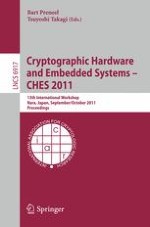2011 | Buch
Cryptographic Hardware and Embedded Systems – CHES 2011
13th International Workshop, Nara, Japan, September 28 – October 1, 2011. Proceedings
herausgegeben von: Bart Preneel, Tsuyoshi Takagi
Verlag: Springer Berlin Heidelberg
Buchreihe : Lecture Notes in Computer Science
